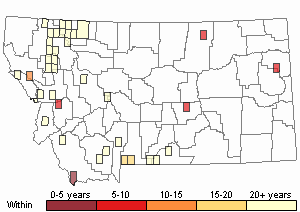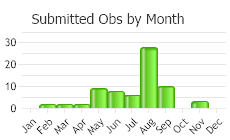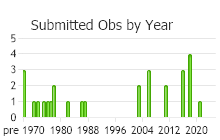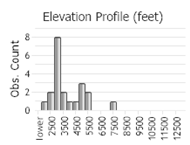View in other NatureServe Network Field Guides
NatureServe
Montana
Utah
Wyoming
Idaho
Wisconsin
British Columbia
South Carolina
Yukon
California
New York
Creeping Feathermoss - Amblystegium serpens
Other Names:
Creeping Conecap Moss,
Amblystegium serpens var. juratzkanum
General Description
Plants: Plants in thin mats, green to chartreuse. Stems freely and erratically branched (FNA 2014), 1-3 cm in length, frequently intermingling; the branches ranging from prostrate to upright (Flowers 1973); central strand present, consisting of diminutive thin-walled cells (FNA 2014).
Leaves: When dry, leaves upright to patent; when moist, patent to spreading (Flowers 1973); slightly concave, ovate to more lanceolate; margins plane, ranging from smooth to serrulate or with larger teeth, lacking a distinctive border; apex acuminate, remaining ungrooved; costa ranging from less than 1/5 to almost the entire leaf length; alar area extending from margin a little over half the distance to the leaf attachment. Stem and branch leaves resembling each other (FNA 2014); stem leaves 0.7-1 mm in length, 0.2-0.4 mm in width; branch leaves a little smaller in both dimensions (Lawton 1971).
Leaf Cells: Basal cells usually somewhat square (Lawton 1971); medial laminal cells 3-5:1, with somewhat thick, sturdy walls, lacking pores; marginal cells 1-layered; alar cells ranging from nearly square to transversely long-rectangular (FNA 2014).
Amblystegium serpens var. juratzkanum is sometimes recognized as a separate taxon based on characteristics of the alar cells and leaf stance (FNA 2014).
Range Comments
Greenland; Canada: AB, BC, MB, NB, NL, NT, NS, NU, ON, PE, QC, SK, YT; USA: AK, AR, AZ, CA, CO, CT, DE, FL, GA, IA, ID, IL, IN, KS, KY, LA, MA, MD, ME, MI, MN, MO, MS, MT, NC, ND, NE, NH, NJ, NM, NV, NY, OH, OK, OR, PA, RI, SC, SD, TN, TX, UT, VT, VA, WA, WI, WV, WY; Mexico; Central America; South America; Europe; Asia; n Africa; Pacific Islands; Australia (FNA 2014). In Montana, known from Clark, Madison, Missoula, Park, Phillips, Ravalli, Roosevelt, Rosebud, and Sanders Counties (Elliott 2016).
Observations in Montana Natural Heritage Program Database
Number of Observations: 74
(Click on the following maps and charts to see full sized version)
Map Help and Descriptions
Relative Density

Recency



 (Observations spanning multiple months or years are excluded from time charts)
(Observations spanning multiple months or years are excluded from time charts)
Habitat
Tree trunks, rotten wood, and soil in wet to dry habitats (Elliott 2016). Amblystegium species are terrestrial; they may live in swampy areas, but not in aquatic or subaquatic places. Elevation: 0-9840 feet (FNA 2014), and recently recorded at 10,860 feet (Kosovich-Anderson 2015).
Reproductive Characteristics
Autoicous (FNA 2014), often freely producing fruit (Flowers 1973). Seta reddish, 10-25 mm tall. Capsule arcuate, 15-20 mm with a visible neck; operculum cone-shaped (FNA 2014).
Stewardship Responsibility
References
- Literature Cited AboveLegend:
 View Online Publication
View Online Publication Elliott, J.C. and A.K. Pipp. 2018. A Checklist of Montana Mosses (1880-2018). Updated 3 January, 2020. Montana Natural Heritage Program, Helena, Montana. 73 pp.
Elliott, J.C. and A.K. Pipp. 2018. A Checklist of Montana Mosses (1880-2018). Updated 3 January, 2020. Montana Natural Heritage Program, Helena, Montana. 73 pp. Flora of North America Editorial Committee, eds. 2014. Flora of North America North of Mexico. Volume 28. Bryophytes: Mosses, Part 2. Oxford University Press, Inc., NY. xxi + 702 pp.
Flora of North America Editorial Committee, eds. 2014. Flora of North America North of Mexico. Volume 28. Bryophytes: Mosses, Part 2. Oxford University Press, Inc., NY. xxi + 702 pp. Flowers, S. 1973. Mosses: Utah and the West. Brigham Young University, Provo, Utah. 567 p.
Flowers, S. 1973. Mosses: Utah and the West. Brigham Young University, Provo, Utah. 567 p. Kosovich-Anderson, Y. I. 2015. Mosses of the Rocky Mountains in Wyoming, U.S.A.: New Altitudinal Records for North America. Arctoa 24:141-147.
Kosovich-Anderson, Y. I. 2015. Mosses of the Rocky Mountains in Wyoming, U.S.A.: New Altitudinal Records for North America. Arctoa 24:141-147. Lawton, E. 1971. Moss Flora of the Pacific Northwest. Hattori Botanical Laboratory. Japan: Yamabuki-cho, Shinjuku-ku, Tokyo. 362 pages plus appendices.
Lawton, E. 1971. Moss Flora of the Pacific Northwest. Hattori Botanical Laboratory. Japan: Yamabuki-cho, Shinjuku-ku, Tokyo. 362 pages plus appendices.
- Additional ReferencesLegend:
 View Online Publication
View Online Publication
Do you know of a citation we're missing? Elliot, J. C. 1993. Second checklist of Montana mosses. Unpublished report. U.S. Forest Service, Region 1. Missoula, MT. 45 pp.
Elliot, J. C. 1993. Second checklist of Montana mosses. Unpublished report. U.S. Forest Service, Region 1. Missoula, MT. 45 pp. Lawton, E. 1971. Keys for the Identification of the Mosses on the Pacific Northwest. Reprinted from 'Moss Flora of the Pacific Northwest'. Published as Supplement No. 2 of the Journal of the Hattori Botanical Laboratory. Nichinan, Miyazaki, Japan. 66 pp.
Lawton, E. 1971. Keys for the Identification of the Mosses on the Pacific Northwest. Reprinted from 'Moss Flora of the Pacific Northwest'. Published as Supplement No. 2 of the Journal of the Hattori Botanical Laboratory. Nichinan, Miyazaki, Japan. 66 pp.
- Web Search Engines for Articles on "Creeping Feathermoss"





